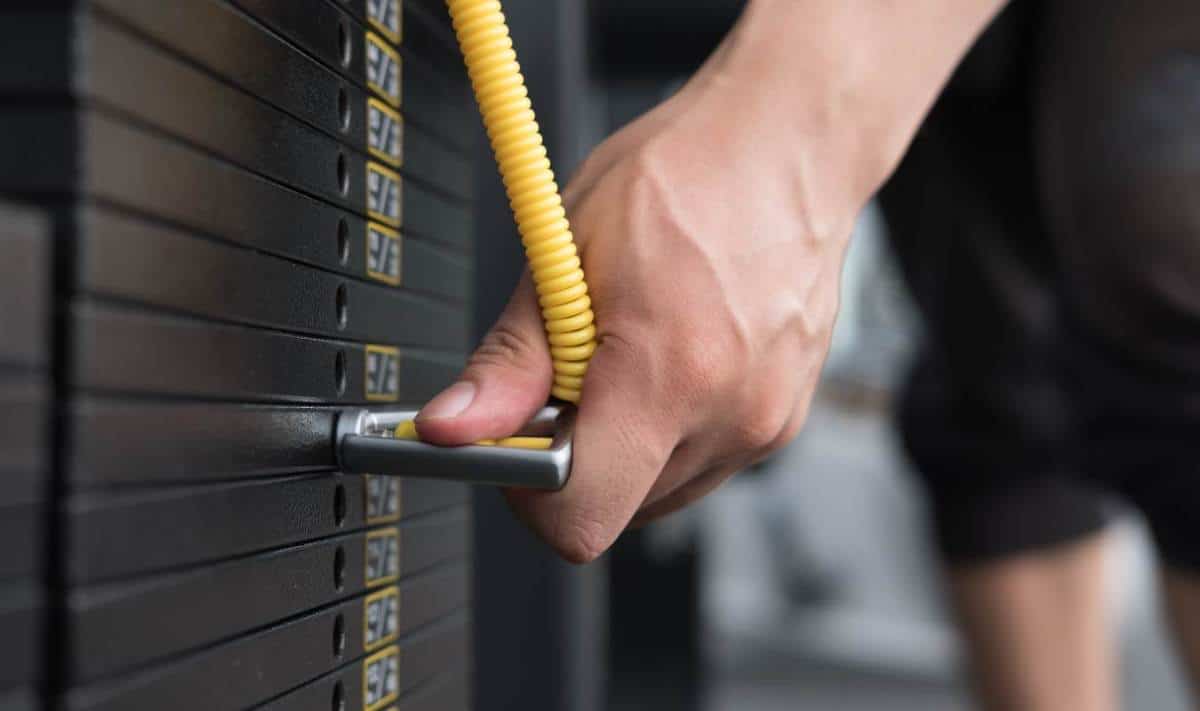
The best online fitness resource you'll ever need. We filter out the BS to ensure you meet your health and fitness goals!

The best online fitness resource you'll ever need. We filter out the BS to ensure you meet your health and fitness goals!

A workout so nice you have to do it twice. Twice a day, that is.
Are you kidding me? Go to the gym twice in one calendar day?
Who does that?
Three groups:
If one of the first two descriptions fit you, keep reading and download our Twice A Day Workout Routine PDF free.
If you’re in the third group, seek help.
I’ve done two-a-days occasionally… rarely actually.
Twice-a-day workouts require an intelligently-written routine, smart application on the doer’s part, proper nutrition, and lots of sleep and recovery. If you’re sure you’re not part of that third group, then keep on reading and let the gains begin!
Jump to the workout plan now!
Alternatively, you can download the free PDF version of the routine using the link below:
| Program style | Resistance training with gym machines |
| Workout duration | 1-2 hours |
| Scheduling | 3 days a week |
| Goal | Build muscle |
| Level | Beginners to advanced |
| Target Gender | Male and Female |
Stating the obvious, you can expect to be going to the gym twice daily on workout days. Well, duh.
You can expect to be following this routine for no longer than 6 weeks. That’s it. Unless your fitness goal is exhaustion and physical depletion.
Once you’re done with this plan, consider our: 6 Day Push Pull Legs Workout Routine
Two-a-days performed with intensity are unsustainable long-term by the musculo-skeleton and central nervous systems.
Right about now, someone is probably asking about boot camp and elite warrior training–think US Navy Seals–and how badass those people are.
They are indeed badass.
Military training is designed primarily to weed people out, not build world class bodies… although the survivors do often develop those. I know a little something about this; my dad was a US Army drill instructor. Alright? So let’s get that out of the way.
Other expectations…
The Twice A Day Workout routine you’ll find here features 6 body part muscle-building workouts.
This Twice-a-Day isn’t intended as an endurance nor a strength workout. You’ll be working to build skeletal muscle – muscles that look good and function well.
Each workout day includes a morning and an evening workout. Workouts should be separated by at least 6 hours.
Morning and evening workouts in the same workout day train opposing body parts. In the case of Legs-Arms day, body parts are combined where working twice daily incurs less risk of over-fatigue.
Shoulders are trained on 2 separate days. The anterior and middle deltoids are trained separately from the posterior delts. The front, middle, and rear delts move the arm in different directions and so can be trained individually.
Days of the week aren’t specified. Which days you train is up to you. Could be Monday-Wednesday-Friday. Could be Monday-Tuesday-Thursday.
| Day | Workout | Body Part |
|---|---|---|
| 1 | Morning | Chest |
| Evening | Posterior Delts | |
| 2 | Morning | Legs |
| Evening | Arms, Abs | |
| 3 | Morning | Back |
| Evening | Anterior, Middle Delts |
This is a 3-day per week program. Two workouts a day is a lot, unless you’re taking anabolics (which I’m not advocating).
Put at least 1 rest day between each workout day, and 2 rest days after the Leg-Arm-Ab day.
Following are three different rest day schedules. Note that all workout days have at least one rest day between them.
Option 1 – First, a traditional spacing, starting with Chest on the first workout of the week:
| Weekday | Split |
|---|---|
| Sunday | Chest, Posterior Deltoids |
| Monday | Rest |
| Tuesday | Quads, Hams, Glutes, Calves, Biceps, Triceps, Abs |
| Wednesday | Rest |
| Thursday | Back, Anterior and Middle Deltoids |
| Friday | Rest |
| Saturday | Rest |
Option 2 – Here’s a spacing that provides for 2 rest days after Leg Day, reputed for how strenuous it can be:
| Weekday | Split |
|---|---|
| Sunday | Chest, Posterior Deltoids |
| Monday | Rest |
| Tuesday | Quads, Hams, Glutes, Calves, Biceps, Triceps, Abs |
| Wednesday | Rest |
| Thursday | Rest |
| Friday | Back, Anterior and Middle Deltoids |
| Saturday | Rest |
Option 3 – Here’s a 3rd arrangement, where Back Day comes first. I love Back Day and look forward to it. Starts the week off right, in my opinion:
| Weekday | Split |
|---|---|
| Sunday | Back, Anterior and Middle Deltoids |
| Monday | Rest |
| Tuesday | Quads, Hams, Glutes, Calves, Biceps, Triceps, Abs |
| Wednesday | Rest |
| Thursday | Chest, Posterior Deltoids |
| Friday | Rest |
| Saturday | Rest |
Feel free to create your own workout-rest day schedule as long as you use good methodology. Remember that recovery is half of building muscle, the other half being quality workouts.
Personally, I would not put Chest and Back days on consecutive days because the deltoids get work in both, even though you’ll be concentrating on different divisions of those muscles.
Just be smart about it.
All the specifics of the workout, along with equipment options and Reps In Reserve recommendations, are in the download. Here’s an overview to give you a general idea of what each workout entails. This uses the Option 1 scheduling above.
| Exercise | Set 1 | Set 2 | Set 3 | Set 4 |
|---|---|---|---|---|
| Chest Press | 15-20 | 10-12 | 8-10 | 8-10 |
| High Incline Press | 15-20 | 10-12 | 8-10 | 8-10 |
| Chest Flyes | 15-20 | 10-12 | 8-10 | 8-10 |
| — break — | — | — | — | — |
| Pullovers | 15-20 | 10-12 | 8-10 | 8-10 |
| Posterior Shoulder Flyes | 15-20 | 10-12 | 8-10 | 8-10 |
| “Y” or “I” Raises | 15-20 | 10-12 | 8-10 | 8-10 |
| Kelso Shrugs | 15-20 | 10-12 | 8-10 | 8-10 |
| Exercise | Set 1 | Set 2 | Set 3 | Set 4 |
|---|---|---|---|---|
| Squats | 15-20 | 10-12 | 8-10 | 8-10 |
| Leg Extensions | 15-20 | 10-12 | 8-10 | 8-10 |
| Hip Adductions | 10-12 | 10-12 | 8-10 | 8-10 |
| Romanian Deadlifts (RDLs) OR Single-Leg B-Stance RDLs | 15-20 | 10-12 | 8-10 | 8-10 |
| Leg Curls | 15-20 | 10-15 | 10-12 | 8-10 |
| Calf Raises | 15-20 | 15-20 | 15-20 | |
| — break — | — | — | — | — |
| Triceps Extensions (Equipment of Choice) | 15-20 | 10-12 | 8-10 | 8-10 |
| Hammer Curls | 15-20 | 10-12 | 8-10 | 8-10 |
| Biceps Curls (Standing or Seated) | 15-20 | 10-12 | 8-10 | 8-10 |
| Crunches | 15-20 | 15-20 | 15-20 | 15-20 |
| Exercise | Set 1 | Set 2 | Set 3 | Set 4 |
|---|---|---|---|---|
| Lat Pulldowns | 15-20 | 10-12 | 8-10 | 8-10 |
| Seated Row | 15-20 | 10-12 | 8-10 | 8-10 |
| Scapula Shrugs | 15-20 | 10-12 | 8-10 | 8-10 |
| — break — | — | — | — | — |
| Machine Lateral Raises | 15-20 | 10-12 | 8-10 | 8-10 |
| Dumbbell Lateral Raises | 15-20 | 10-12 | 8-10 | 8-10 |
| Front Raises | 15-20 | 10-12 | 8-10 | 8-10 |

Few principles apply universally to training; progressive overload is one of the few.
Progressive overload is synonymous with gains. Challenge the muscle, it adapts, add challenge. Very simple yet effective.
Once the set of a given exercise is mastered for the specified reps and weight, increase the weight. Strength gains are the natural and observable outcome.
For muscular development–hypertrophy–intensity and stressing the muscle to mechanical failure should also result in size, density, and shape increases.
Let’s look at an example:
Let’s say the program calls for sets of 8 to 10 repetitions. Reps 9 and 10 are easy enough that you could easily do 11 or 12 before your form suffers.
Increase the weight so that rep #8 is hard. Continue using that weight until you can once again do all 10 and maybe the 11th. Then repeat the process.
What if–on your last set of 8 to 10–you can only get 7 reps? Drop the weight just enough to squeeze out the 8th or 9th.
Progressive Overload permits you to follow the same program indefinitely because you’re adding resistance as the body adapts.
If it’s not adapting, you do a thing called “unloading”. Apply the principle in reverse.
Back off the resistance by adding reps or reducing the weight for a week or two, then repeat the process of achieving the rep range and increasing weight as you do.

Reps in Reserve (RIR) and rep cadence (which we’ll cover in a moment) influence how well the muscles respond.
Two workouts a day makes for a big workload. Means you need to be really smart about when you “say when” during a set.
Best application for this program is 1 to 2 reps in reserve for the first 2 sets, and then no RIR for the third and fourth.
Perform all reps perfectly. Zero RIR is no excuse for poor execution.
After a few workouts if you begin to feel overtrained, back off and leave 1 to 2 RIR in all your sets for a week or two. It won’t cost you and you’ll lower your risk of chronic overuse injuries.
Symptoms of overtraining include:
And here’s a big one:
OK so here’s the brutal truth.
If you’re like almost all gym-goers–and let’s face it, you probably are–you have no clear idea what true mechanical failure is when you sense it.
No insult intended, but let’s just be honest with ourselves.
Clinical evidence in the exercise science literature bears this out: people underestimate their exertion and can do more reps than they think they can when put to the test.
The final reps of any good set are going to go up a lot more slowly than the first reps. In really, really good muscle-building sets, the last reps will move like a glacier even when straining with everything you’ve got.
Let’s say it another way: if the last reps of your set look and feel the same as the first, you just wasted your time. Don’t be lookin’ in the mirror because there will be no changes. Sorry.
Rhythm is key. Smooth, steady, with a squeeze in the contracted position. Think about “flexing” the weights up.
Under no circumstances use momentum of any kind. In this routine, you’re not going for personal best lifts. The numbers on the weights don’t matter. It’s all about what your muscles experience.

Change the days if that works better for you based on whatever else you’ve got going on in your life and your weekly routine.
Nothing says you can’t create your own workout-rest day schedule. Remember that recovery is half of building muscle, the other half being quality workouts.
Just arrange your workouts and rest days to give your muscles time to rebound. I would not put Chest and Back days on consecutive days; the deltoids get work in both.
AGAIN, do what you need to do and be smart!!
For suggested reading, I cite these references on rest and recovery from the clinical literature:
Level of fitness, your training focus, life stressors, diet, and amount of sleep all influence how you organize your rest days.
Aim for 3 minutes of rest between your “working” sets, where you’re taking each set to the point when your form begins to break down (aka mechanical failure).
Use your rest time productively. Be your own toughest critic. Analyze:
Then, visualize your next set. Perform it in your head.
If you’re fortunate enough to train with someone more experienced than you, use your rest time to ask for feedback.
Champion bodybuilders from the golden years – Arnold, Franco, and their contemporaries – did that all the time.
Check out the documentary “Pumping Iron” for examples and some fun watching in general. A must-watch for any serious musclehead.
Download our Twice a Day Workout Plan PDF below:
We write custom programs. If you have specific physique goals–such as “I’d like wider shoulders”, or “I’d like more ‘V’ in my back”–we can write one for you. Reply in the Comments or simply contact us and we’ll get back in touch. First come, first served.